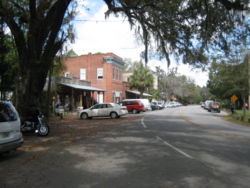Micanopy, Florida
| Micanopy, Florida | |
|---|---|
| Town | |

Micanopy commercial district
|
|
 Location in Alachua County and the state of Florida |
|
| Coordinates: 29°30′23″N 82°16′55″W / 29.50639°N 82.28194°WCoordinates: 29°30′23″N 82°16′55″W / 29.50639°N 82.28194°W | |
| Country |
|
| State |
|
| County | Alachua |
| Area | |
| • Total | 1.1 sq mi (2.8 km2) |
| • Land | 1.0 sq mi (2.7 km2) |
| • Water | 0.04 sq mi (0.1 km2) |
| Elevation | 125 ft (38 m) |
| Population (2010) | |
| • Total | 600 |
| • Density | 571/sq mi (220.6/km2) |
| Time zone | Eastern (EST) (UTC-5) |
| • Summer (DST) | EDT (UTC-4) |
| ZIP code | 32667 |
| Area code(s) | 352 |
| FIPS code | 12-45225 |
| GNIS feature ID | 0286767 |
| Website | www |
Micanopy (/mɪkəˈnoʊpi/ mik-ə-NO-pee) is a town in Alachua County, Florida, United States, located south of Gainesville. The population as of the 2010 census was 600. The town center is listed on the National Register of Historic Places and contains a number of antique stores, as well as several restaurants.
In 1539 Spanish conquistador and explorer Hernando De Soto noted a Timucuan Indian village at the site of present-day Micanopy. Over two hundred years later, the American naturalist William Bartram recorded his impressions of a proto-Seminole village named Cuscowilla in this same locale.
By the time Spain ceded its Florida provinces to the U.S. in 1821, the newly constructed hamlet of Micanopy became the first distinct United States town in the Florida Territory. One of the founders was Moses Elias Levy, a wealthy businessman and philanthropist who was involved in West Indies shipping and other interests. He came to the United States in 1820.
Named after a Seminole chief, the village of Micanopy was built under the auspices of the Florida Association of New York (the earliest Florida development corporation, headquartered in Manhattan). Chief Micanopy lived about 60 miles (97 km) south in present-day Sumter County. In 1821 when the territorial village was developed, a faction of Miccosukee Indians lived in the immediate area. The historian C. S. Monaco has suggested that the town was named after Micanopy "to appease the chief and acknowledge his original authority over the land."
...
Wikipedia
